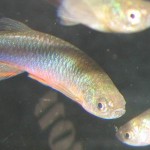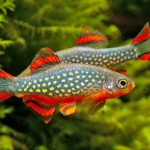As beginning fish keepers most of us kept some Zebra Danios, but once we get a bit of experience, we think of them as beginner fish and move on to bigger and better. This is rather sad because there are literally dozens of different Danios available.

The group of fish we call Danios is quite diverse and includes both small and large species. They are peaceful, very attractive, inexpensive, and best of all, very easy to keep. Danios are members of the carp family, and range in size from just under an inch, up to around 6 inches. Danios are split into two main genera, Danio and Devario, but the group also includes some close relatives like Sundadanio, Danionella and Microrasbora.
In the hobby, we collectively call all of them Danios , but this can make things rather confusing if you are trying to talk about only the members of the Danio genus. As all of these fish are members of a minnow subfamily called the Danioninae, pedants (such as myself) think that it’s wiser to call all of the fish in the group Danionins (pronounced daneeohnins), rather than Danios. I believe it was Matt Clarke that first coined this term. I liked it so much that I started a website using the name www.danionins.com.

Now I know you have heard, all danionins are fast swimming, mid-water or surface dwelling fish, and generally live in fast flowing shallow rivers and streams. This is simply NOT true. Wild Zebra Danios inhabit slow moving water, typically in floodplains, oxbows, slow streams and established rice paddies. Any sluggish body of water with a heavily silted bottom, or sometimes gravel and cobbles, will become home. A great many of the Danios & Devarios found in Myanmar, live in either shallow still-water ponds and paddies, or large still-water lakes such as lake Inle. Another often cited myth about Danionins is that they require tropical water temperatures. Most of them will prefer their water a bit cooler and are actually more subtropical than tropical, and a few will actually perish if kept in water that is too warm.
Since they do tend to live in groups, it’s best to keep a shoal of six or more. In fact, if you have the tank space, with Danionins it’s the more the merrier! It is also generally fine to mix different species of Danionins together, and there is rarely any problem in keeping larger Devario alongside smaller Danio and Devario species.
These fish have become my passion over the last decade, and it’s amazing to me how much mis-information gets repeated about these fish on most of the forums. There is good information to be found however, and a couple of my favorite sites are Pete Cottle’s Danios and Devarios and Seriously Fish.
I could go on and on about Danios, but I’ll stop here. The next time you’re looking for something different for your tank, check out the variety of Danios now in the hobby. We’re not limited to just your Dad’s Zebra Danios anymore!